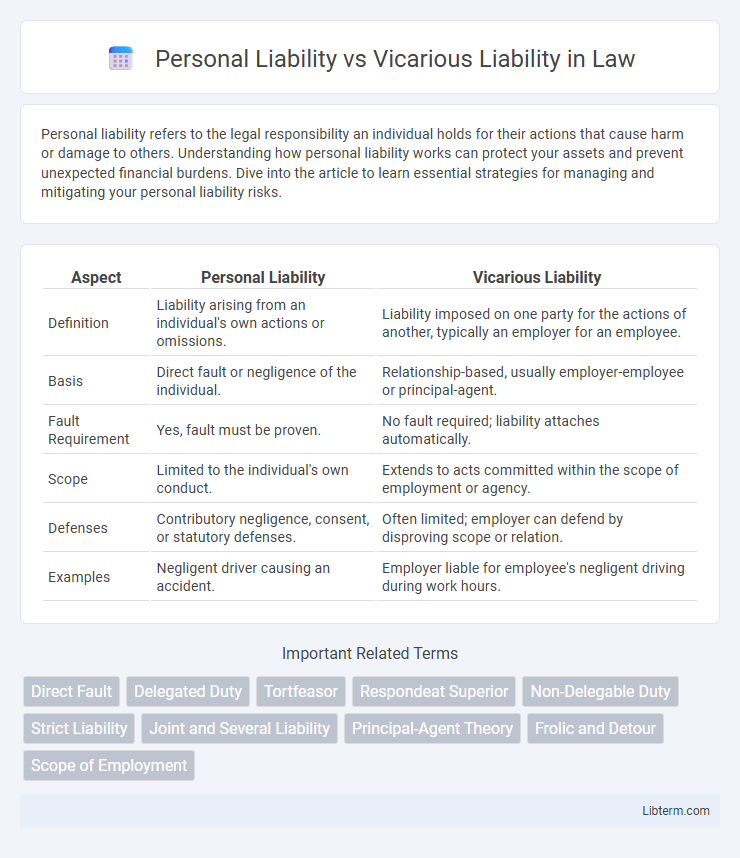Personal liability refers to the legal responsibility an individual holds for their actions that cause harm or damage to others. Understanding how personal liability works can protect your assets and prevent unexpected financial burdens. Dive into the article to learn essential strategies for managing and mitigating your personal liability risks.
Table of Comparison
| Aspect | Personal Liability | Vicarious Liability |
|---|---|---|
| Definition | Liability arising from an individual's own actions or omissions. | Liability imposed on one party for the actions of another, typically an employer for an employee. |
| Basis | Direct fault or negligence of the individual. | Relationship-based, usually employer-employee or principal-agent. |
| Fault Requirement | Yes, fault must be proven. | No fault required; liability attaches automatically. |
| Scope | Limited to the individual's own conduct. | Extends to acts committed within the scope of employment or agency. |
| Defenses | Contributory negligence, consent, or statutory defenses. | Often limited; employer can defend by disproving scope or relation. |
| Examples | Negligent driver causing an accident. | Employer liable for employee's negligent driving during work hours. |
Definition of Personal Liability
Personal liability refers to the legal responsibility an individual holds for their own actions or omissions that cause harm or damage to others. It requires direct involvement or negligence by the person held accountable, making them personally answerable for any resulting claims or damages. This contrasts with vicarious liability, where an entity is held responsible for the actions of another, typically an employee or agent.
Definition of Vicarious Liability
Vicarious liability refers to a legal doctrine where one party is held responsible for the actions or omissions of another, typically an employer being liable for the acts of an employee performed within the scope of employment. Unlike personal liability, which arises from an individual's own actions or negligence, vicarious liability assigns accountability based on the relationship between the parties involved. This principle ensures that employers or principal entities bear responsibility for harm caused by their agents, promoting accountability in organizational and business contexts.
Key Differences Between Personal and Vicarious Liability
Personal liability holds an individual directly responsible for their own negligent or intentional acts, whereas vicarious liability assigns responsibility to someone else for another person's actions, typically an employer for an employee. Personal liability requires proof of fault or wrongdoing by the individual, while vicarious liability is based on the relationship between the parties, regardless of fault. Understanding these distinctions is critical for legal accountability in tort law and risk management within organizations.
Legal Basis for Personal Liability
Personal liability arises from an individual's direct actions or omissions that cause harm or damage, grounded in principles of tort law and contract law, where the responsible party is held accountable for their own negligence or intentional misconduct. This legal basis mandates that individuals bear financial or legal responsibility for breaches of duty, ensuring compensation for victims and deterrence against wrongful acts. Courts assess personal liability by examining evidence of fault, causation, and damages under established statutory regulations and case law precedents.
Legal Basis for Vicarious Liability
Vicarious liability is grounded in the legal principle of respondeat superior, which holds employers responsible for the wrongful acts committed by their employees within the scope of employment. This doctrine imposes liability based on the relationship between the parties rather than the personal fault of the employer. Courts apply this legal basis to ensure victims receive compensation when harm results from an employee's actions performed during their authorized duties.
Examples of Personal Liability in Everyday Life
Personal liability in everyday life often arises when individuals cause harm or damage through their own actions, such as a homeowner being held responsible for injuries sustained by a guest due to negligence, or a driver facing liability for an accident caused by reckless driving. Another common example includes a pet owner held personally liable for injuries inflicted by their dog. These scenarios illustrate personal accountability based on direct actions or omissions leading to harm.
Common Scenarios for Vicarious Liability
In common scenarios for vicarious liability, employers are held responsible for the wrongful acts committed by their employees during the course of employment, such as a delivery driver causing an accident while making deliveries. Another typical example includes a principal being liable for the actions of an agent acting on their behalf within authorized duties, like a real estate agent entering into contracts for their brokerage. These situations illustrate how organizations or individuals can be legally accountable for others' conduct under the doctrine of vicarious liability.
Employer Responsibility and Vicarious Liability
Employers bear significant responsibility under vicarious liability, which holds them accountable for the negligent acts of their employees performed within the scope of employment. This legal doctrine ensures that employers can be held liable for damages resulting from employee actions, even if the employer was not directly at fault. Personal liability, in contrast, applies to individuals who commit wrongful acts themselves, emphasizing the distinction between direct and vicarious responsibility in legal contexts.
Limiting Exposure to Personal and Vicarious Liability
Limiting exposure to personal and vicarious liability involves implementing comprehensive risk management strategies, such as acquiring adequate insurance coverage and establishing clear contractual agreements that delineate responsibilities. Businesses should conduct regular training and enforce strict compliance protocols to minimize negligent acts that could trigger personal or vicarious liability claims. Additionally, structuring operations through legal entities like corporations or LLCs can shield personal assets from liability arising from employee actions.
Importance of Understanding Liability for Legal Protection
Understanding the distinction between personal liability and vicarious liability is crucial for effective legal protection and risk management. Personal liability holds individuals accountable for their own actions or negligence, while vicarious liability assigns responsibility to one party for the actions of another, often in employer-employee relationships. Clear knowledge of these liabilities enables individuals and businesses to implement appropriate safeguards, reducing financial exposure and legal repercussions.
Personal Liability Infographic

 libterm.com
libterm.com